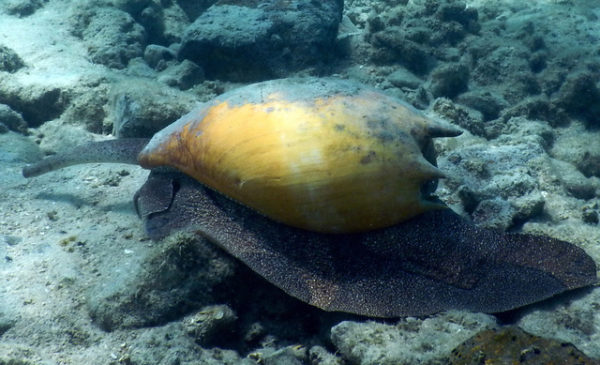Published in the Ocean Watch column, Honolulu Star-Advertiser © Susan Scott
November 19, 2016
Black Island, Great Barrier Reef Marine Park >> While anchored off this small, round, wooded islet, Craig and I started snorkeling on its leeward coral side and later emerged to walk the sand beach on its windward rocky side. As time passed, the tide rose so high we had to abandon the beach walk and swim over the rock bottom.
Thank heaven for big tides.
Craig touched my arm and jabbed his finger below us. “Wait,” he said, raising his head. “I lost it.”
 The baler snail lives in small communities, never traveling very far from the area in which it is born,
The baler snail lives in small communities, never traveling very far from the area in which it is born,
quite often in isolated areas in Black Island, Great Barrier Reef Marine Park.
©2016 Susan Scott
We peered down and saw only gray rocks. And then there it was, a spaghetti squash creeping along on a black-and-white carpet. Its leading organ resembled an elephant trunk. It was hard to keep track of the animal because its appearance changed depending on viewing angle. One side of the creature’s bulbous oval shell was yellow, but the other was a rocklike gray.
The animal was a big, breathtaking snail, but what kind I did not know.
Thank heaven for field guides.
Our crawling beauty was a baler snail. “Baler” is a misspelling of the word “bailer,” dating to when Europeans first saw islanders use the shells to bail water from their canoes. The scientific name for this snail family of over 50 species is Volutidae, shortened to the common name volute.
Volutes are famous for their dramatically patterned shells, feet and tentacles, each different from one another. One endemic species here on the Great Barrier Reef is described as “a carnival of colour, the stripes and spots of its shell pale in comparison to its luridly painted foot and tentacles.”
Volutes are also famous here for species being isolated, each found on only one reef or a small group of reefs. That’s because these snails, as opposed to most others, have no planktonic stage. Their eggs hatch on the bottom as crawling juveniles that stay in the neighborhood where they were born. Being a species in only one small area makes volutes exceptionally vulnerable to extinction through pollution, cylcones and over-collecting.
Each volute walks around the ocean floor on its large muscular foot looking for clams and other snails to dig up and eat. The photos of our volute clearly show a digging claw on each side of its carpetlike foot. Its “trunk” is a water siphon through which the animal circulates water over its gills, extracting oxygen and releasing carbon dioxide.
For half an hour we watched the 12-inch-long creature slide gracefully among the rocks of its own little island.
The experience of seeing and learning about this rare creature was a highlight of our exploration of the Great Barrier Reef.
Thank heaven for baler snails.